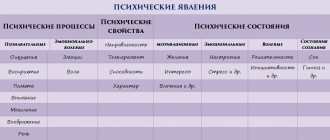Mental health is a very sensitive topic. Clinical manifestations of mental disorders depend on the age of the child and the influence of certain factors. Often, due to fear for future changes in their own life, parents do not want to notice some problems with the psyche of their child.
Many people are afraid to catch the sidelong glances of their neighbors, feel the pity of their friends, or change their usual life order. But the child has the right to qualified, timely assistance from a doctor, which will help alleviate his condition, and in the early stages of certain diseases, cure a mental disorder of one spectrum or another.
One of the complex mental illnesses is childhood psychosis. This disease is understood as an acute condition of a child or a teenager, which manifests itself in his incorrect perception of reality, his inability to distinguish the real from the imaginary, and his inability to really understand what is happening.
Somatoform and neurotic disorders associated with stress
The combination of somatoform and neurotic stress-related disorders into one large group is based on the fact that most of these pathologies have psychological causes. In addition, this group of disorders has many historical connections with the general concept of neuroses.
This category of disorders includes:
1. Phobias (fears). Patients suffering from phobic anxiety disorders experience feelings of fear in certain situations or in the presence of external objects that do not pose a real threat. There are different types of phobias. Children and adolescents may be afraid of increased attention from other people; such disorders are commonly called social phobias. Isolated or specific phobias, limited to specific situations or objects, are also known. The patient may experience anxiety when flying on an airplane, when seeing blood, when visiting public toilets, etc.
2. Panic attacks, agoraphobia. Agoraphobia is usually understood as a fear of open space. The patient experiences a feeling of anxiety in front of a large number of people (crowd), and also panics at the thought that it is impossible to quickly return to a comfort zone, for example, home. A distinctive feature of this type of disorder from other types of phobias is that patients rarely experience strong anxious feelings. Since the main part of their activity is aimed at avoiding phobic situations. Agoraphobia is often accompanied by panic attacks.
3. Obsessive-compulsive disorder (obsessive thoughts and actions, trichotillomania, onychophagia). This type of disorder is characterized by the presence of obsessive thoughts or compulsive actions that are painful for the patient. The development of pathology begins in childhood; obsessive disorders are equally common in both girls and boys.
4. Somatoform disorders (cardioneurosis, gastroneurosis, irritable bowel syndrome, psychogenic pain syndrome, etc.) The appearance of such disorders is associated with emotionally significant stressful situations that the patient has experienced. Complaints about painful symptoms may occur in a child raised in a family where only sick children receive love and support.
Other pathological conditions can also be classified as neurotic disorders associated with stressful situations. In most cases, there is a combination of various symptoms, although the most common are depression and anxiety of varying severity.
Recommendations for parents
Every parent concerned about the mental health of their child should remember:
- do not forget that psychosis is a disease that needs treatment;
- treatment should be started in a timely manner, and the visit to specialists should not be delayed;
- it is necessary to consult with several specialists, because proper treatment is the key to success;
- for the treatment and prevention of the disease, the support of family and friends is important;
- goodwill towards the patient speeds up the treatment process and ensures lasting results after treatment;
- after treatment, the baby must be returned to a normal environment and make plans for the future;
- it is necessary to create a calm atmosphere in the family: do not shout, do not practice physical or moral violence;
- take care of the baby’s physical health;
- avoid stress.
Love and care are what any person needs, especially a small and defenseless one.
Mood disorders (depression and mania in children and adolescents)
The first signs of mood disorders can appear in children aged 5-6 years, but most often this type of mental disorder occurs in adolescents. This is due to the peculiarities of puberty and social adaptation during this period of life. There are two types of mood disorders:
- depressive disorders are characterized by attacks of depression (Episodes of low mood), without attacks of mania;
- Bipolar disorders are characterized by alternating episodes of depression and mania. The period of depression is followed by a period of elation, with a return to normal between attacks.
Cases where attacks of mania are observed without the presence of depressive periods are extremely rare.
Most often, the development of mood disorders is associated with stress, for example, the death of a loved one, constant criticism from parents or teachers, rejection by peers, or a series of tragedies. But the predisposition to the development of such conditions can be inherited.
Types of psychotic disorders among children
Children's mental illnesses are divided according to certain criteria. Depending on age, there are:
- early psychosis;
- late psychosis.
The first type includes patients with mental disorders of infancy (up to one year), preschool (from 2 to 6 years) and early school age (from 6-8). The second type includes patients of pre-adolescence (8-11) and adolescence (12-15).
Depending on the cause of the disease, psychosis can be:
- exogenous
– disorders caused by exposure to external factors; - endogenous
– disorders provoked by the internal characteristics of the body.
Depending on the type of course, psychoses can be:
- reactive
, which arose as a result of prolonged psychological trauma; - acute
– arising instantly and unexpectedly.
A type of psychotic disorder is affective disorder. Depending on the nature of the course and symptoms of affect disorders, there are:
- depressed;
- manic;
- schizoaffective;
- organic.
Schizophrenia, schizotypal disorder, schizoaffective disorder in children and adolescents
Nosological units such as schizophrenia, schizotypal and schizoaffective disorder are combined into one group because they have many of the same symptoms:
1. Schizoaffective disorders are characterized by the presence of affective and schizophrenic symptoms simultaneously; attacks can last several days. In the intervals, the patient’s condition can be regarded as normal, close to recovery. Personality changes observed in schizophrenia begin to appear after 3-5 attacks. The etiology of the disease has not been fully identified; it is assumed that this type of disorder is one of the varieties of schizophrenia.
2. Schizotypal disorder is accompanied by eccentric, slightly strange behavior, anomalies of emotions and thinking. Similar deviations are observed in patients with schizophrenia. But the course of the shipopic disorder does not correspond to the main stages of schizophrenia. Diagnosing this type of disorder is quite difficult, since the lack of severity of symptoms makes it similar to a simple type of schizophrenia, as well as paranoid personality disorder. In this regard, schizotypal disorder is often called latent schizophrenia.
3. In schizophrenia, there is a progressive change in personality that cannot be corrected. This type of mental illness is rare in children at an early age, but it can be diagnosed as early as 2-3 years. The first sign is the child’s fading interest in games and lack of reaction to the affection of loved ones. Then comes a period of extinction of mental activity and inhibition of mental development. The tendency to schizophrenia is inherited, but any stressful situation can trigger the progression of the disease.
All forms of schizophrenia are difficult to correct. The patient cannot be cured completely; only some improvements can be achieved. For disorders that have symptoms similar to schizophrenia, the prognosis is more favorable.
Diagnostic criteria and methods
Despite the proposed list of signs of psychosis, no parent can definitely and accurately diagnose it on their own. First of all, parents should take their child to a psychotherapist. But even after the first appointment with a professional, it is too early to talk about mental personality disorders. A small patient should be examined by the following doctors:
- neurologist;
- ENT;
- speech therapist;
- psychiatrist;
- a doctor who specializes in developmental diseases.
Sometimes the patient is admitted to a hospital for examination and necessary procedures and tests.
Organic diseases of the brain (in particular cerebrasthenic syndrome)
The diagnosis of “organic brain damage” has recently become very common. This is due to the fact that this formulation describes not one disease, but a number of individual pathologies. All of them are characterized by changes in the structure of the brain. In most cases, organic changes do not have a significant effect on the functioning of the central nervous system; pronounced symptoms begin to appear if more than 20% of the brain is damaged. With more serious injuries, persistent pathological syndromes appear, one of them is cerebrasthenic syndrome.
In children, organic brain damage is most often associated with intrauterine infections or birth injuries. But other reasons can also lead to the development of organic diseases. Cerebrasthenic syndrome develops as a result of oxygen starvation of the brain. The patient cannot concentrate and absorb large amounts of information and gets tired quickly.
Cerebroasthenic syndrome can develop at any age.
If the problem is ignored, the child’s psyche does not develop at a normal pace, but modern medicine allows for successful treatment. Children with various organic brain injuries today have a chance to recover and lead a full life in the future.
While growing up, a child faces many challenges, including teenage stress. Stress is a common cause of mental illness among adolescents. If you do not provide the child with proper support during adolescence, then everything can end with a nervous disease at a more mature age, which is practically untreatable.
If parents notice drastic changes in a teenager’s behavior—he changed his hobbies, stopped being interested in things that had been dear to him for a long time—then this indicates some problems.
You shouldn’t immediately start pestering your child with questions about love, problems at school or with drugs; you need to get advice from a teenage psychologist. About how to identify a disorder by symptoms, how to help a child survive a difficult period.
Let's take a closer look at this.
Signs of mental disorders in teenagers
It is during adolescence that many mental illnesses begin to form, including schizophrenia and various types of psychoses.
Signs of such disorders include the following symptoms:
- the child has a new hobby to which he devotes all his time, but there is no success;
- abruptly abandoned old hobbies;
- began to do poorly at school when he had previously achieved significant success;
- I lost interest in everything I was previously passionate about.
But these symptoms do not 100% indicate mental disorders in adolescents. Perhaps this is how the accentuation of character manifests itself, which we will discuss in the following sections.
Symptoms
Symptoms of mental disorders in adolescents aged 12-18 years are manifested by the following features:
- sudden changes in mood, aggressiveness, conflicts with parents, teachers and other children, impulsiveness, melancholy, anxiety, inconsistency;
- disdainful attitude towards adults;
- excessive self-criticism or, on the contrary, excessive self-confidence;
- explosive reaction to outside advice and criticism;
- sensitivity is combined with callousness, the teenager is shy, but at the same time very irritated;
- refusal to obey generally accepted rules;
- schizoid;
- refusal of any guardianship.
If you notice only one of the points in your child’s behavior, then you don’t need to worry, just talk to him and find out the reason for the change.
Mental disorders in adolescents are indicated by a combination of several or all of the following symptoms.
Should I contact a specialist?
Parents usually prefer not to seek advice from a teenage psychologist. Some people think that it is a shame to take a child to a shrink, or that this will only worsen the situation, and the child will withdraw more into himself, lose trust in his parents, and so on.
In fact, it is necessary to contact a specialist.
Today, many psychologists work anonymously, that is, no one at school will know about a teenager’s visit to a doctor, and he may not even say his name.
To understand whether it is necessary to visit a psychologist in a particular case, answer a few questions:
- The above describes the signs of mental disorders in adolescents. Remember how dramatically the child has changed. If everything is fine in the family, there are no quarrels or sudden changes (divorce, death of a relative, etc.), and changes have become noticeable, then it is difficult to do without a psychologist. If the child smoothly switched to other interests or abruptly, but not everything is going smoothly in the family, then these symptoms may be an accentuation of character or an expression (involuntary) of internal experiences.
- Pay attention to your teen's sleep and appetite. If a child does not sleep well and refuses to eat, then it is worth visiting a specialist.
- If a child is in a long-term depressed state, he is not interested in anything, delusions and hallucinations appear, then urgently seek help from a professional.
Here I would like to note that many parents confuse melancholy in a teenager, which is typical for adolescence, with depression .
If, apart from this condition, nothing else bothers the child (he eats and sleeps as before, has not lost interest in his hobbies, and so on), then this is simply a difficult age threshold, which good parents themselves will help to overcome. Spend more time with your child, talk, but don’t “torture” him if he doesn’t like a topic, walk together, listen to him. During adolescence, even a simple hug will help.
If a teenager himself understands that something is wrong with him and tries to get rid of this condition and return life to its previous course, then this is a good sign. Most likely, he has a simple neurosis due to adolescence, study, relationships with the opposite sex, and the like.
If a serious mental illness is planned, then the teenager will perceive the new self calmly, and he will not have the desire to fix anything. There are specific disorders in the way of thinking of a teenager, but they are almost impossible to notice with an unprofessional eye.
To exclude or confirm a mental disorder in a teenager leading to a serious illness, it is still recommended to consult a psychologist.
If the specialist does not see any warning signs, then you can go home with peace of mind and a few tips from a professional. If alarming signals are detected, the doctor will help adjust the situation at home by talking with parents and other family members.
The specialist will also help the child learn to be in school and other public places with minimal psychological trauma.
We propose to consider the question of what mental disorders occur most often in adolescents.
Character accentuation and psychopathy
Only a professional psychologist who practices working with children and adolescents can understand what is happening to a teenager - character accentuation or psychopathy, since the line between the concepts is very thin.
During accentuation, some character traits begin to clearly sharpen, and by external signs this may resemble the picture of the development of psychopathy.
The first step is to make sure there is a normal social environment at home. As a rule, adolescents are less likely to suffer from psychopathy if their family is prosperous.
The diagnosis must be made carefully and can only be reported to the teenager’s parents and teachers. At the same time, the psychologist must explain to the parties the difference between character accentuation and psychopathy, so as not to accidentally label the teenager as “psycho.”
Melancholy
When a teenager begins to experience hormonal changes, he changes his behavior. A melancholic state is the norm of adolescence, and should not be confused with depression.
The first signs of melancholy may be a teenager’s complaints about a restless state of mind. He withdraws into himself against this background. There may also be attacks of aggression, including those directed at oneself.
Young people in this state are often disappointed in themselves. At such moments, a teenager should not be left alone. The world loses color for him, it seems empty and worthless, in this state many think about suicide, and some even attempt to commit suicide. The teenager thinks that no one needs him.
Signs of melancholy
If you notice at least half of the listed signs of melancholy, then immediately contact a specialist.
Symptoms include the following changes:
- vulnerability, tears even out of nowhere;
- mood changes for no reason;
- self-isolation, closure;
- frequent attacks of aggression over trifles;
- insomnia;
- excessive appetite or lack thereof;
- decline in school performance;
- constant fatigue, malaise.
Affective insanity
The picture of the development of such a mental disorder in a teenager is very similar to melancholy, but is no longer the norm during adolescence.
The main danger of the disorder is a crime of law against the background of depression, and also not an attempt at suicide, but its real possibility.
It is not easy to distinguish melancholy from manic-depressive psychosis.
Please note that in the first case, the teenager’s mood often changes, and in the second, he remains in a manic mood for some time, that is, he is passionate about something, cheerful, full of energy and plans, and separation from activities leads to aggression.
A manic mood often changes to a depressive one - the collapse of all hopes, bad memories, dissatisfaction with life and oneself. It is very difficult to pull a teenager out of such a state.
If you notice such symptoms in your child, then immediately take him to a specialist.
Schizophrenia
This disorder is very similar to manic-depressive psychosis. All the symptoms coincide - at first the mood is manic, enthusiastic, and then prolonged depression begins. There is a difference, and it is the main thing - with schizophrenia, panic attacks, delirium, and hallucinations are possible.
Summarize
Problems in adolescence are an integral part of growing up.
If you see that something is going on with your child, do not ignore it, thinking that adolescence will pass on its own.
If you do not help a teenager during this difficult time for him, the consequences can be very dire: from the development of a serious mental illness to the child’s suicide.
Source
WHO. Mental disorders in children and adolescents
WHO. Suicide prevention. Reference Guides
Where to turn for help when you urgently need to talk, but it’s difficult to get to a psychologist or dial a helpline number.
Here is a selection of free services that provide online help and are staffed by specialists and trained volunteers. These are resources where you are not afraid to talk about difficulties.
Internet service for emergency psychological assistance of the Ministry of Emergency Situations of Russia
Who created: Ministry of Emergency Situations of the Russian Federation.
A free psychological assistance service where you can get a one-time consultation or register and create a personal account to communicate with a personal consultant. Psychodiagnostic testing is carried out in your personal account; the consultant recommends exercises to cope with the problem. Plus, the site has a section with articles from service consultants.
Hotline phone number: 8-499-216-50-50.
Ask for help
Help is at hand
Who created: the organization “Doctors for Children”, which supports families and protects the rights of children.
Supporting teenagers and children in difficult situations. The project website has two sections: for children from 6 to 12 years old and for teenagers. They are slightly different, but the main thing is the ability to get advice from a psychologist via chat, write a letter and find phone numbers to call. The chat is open from 11:00 to 23:00 Moscow time.
The project has a group on the VKontakte social network.
Ask for help
Your territory
Who created: the “Your Territory” foundation, which specializes in protecting children’s rights.
Another online help service for teenagers, where you can talk about everything that worries them during adolescence.
The consultant works from 15:00 to 3:00 - just after school ends, and at a time when unnecessary thoughts enter your head.
The project also has a group on the VKontakte social network.
Ask for help
Psychological assistance service
Who created: the state budgetary institution “Moscow Service for Psychological Assistance to the Population.”
Remote counseling is provided not only for Moscow residents. Consultations are conducted online (upon prior request), by email, and in the psychological support forum.
Ask for help
Helpline
Who created: Fund to support children in difficult life situations.
Both adults and children can ask questions on the site. If you don’t have the strength to call, leave a message to the online consultant, and the answer will be sent by email.
A single all-Russian helpline for children, teenagers and their parents: 8-800-2000-122.
Ask for help
I'm a parent
Who created: Fund to support children in difficult life situations.
Online consultations on parenting and difficult situations in relationships with children. Questions are published on the website, but consultations are anonymous.
Ask for help
Read also:
- Consultation with a specialist. Prevention of mental disorders
- Mental health. How to improve
- Teenage drug addiction and causes of drug addiction
- On the activities of Rospotrebnadzor to prevent suicide among children and adolescents
- WHO. Suicides can be prevented
Eating disorders (anorexia nervosa, bulimia)
Various eating disorders have become very common lately. Most often, these types of disorders affect adolescent girls, young women and young women. The danger of these pathologies is that any nutritional disorders lead to serious physical health problems, even death.
Anorexia nervosa develops in children who have a distorted perception of their own body. Emotional abuse of a child at an early age can lead to the development of such mental disorders. Bulimia is characterized by bouts of compulsive overeating, which are followed by periods of regret. The patient tries to artificially induce vomiting in order to get rid of what he has eaten.
Bulimia nervosa and anorexia most often develop during adolescence. This is due to the fact that at this age, worries about appearance and excess weight often arise. The basis of treatment for eating disorders is psychotherapy, aimed at changing the patient’s perception of his own body and raising self-esteem.
Features of childhood psychoses
Mental disorders and psychoses in children are not diagnosed as often as in adult men and women. Mental disorders come in different types and forms, but no matter how the disorder manifests itself, no matter what symptoms the disease has, psychosis significantly complicates the life of the child and his parents, prevents him from thinking correctly, controlling actions, and building adequate parallels in relation to established social norms.
Childhood psychotic disorders are characterized by:
- Delayed development of skills and intelligence. This feature appears in most cases. But there are diseases, for example, autism, during which the child has bright and advanced abilities in some area of activity. Experts say that in the early stages, mental disorders in children are difficult to distinguish from simple developmental delays, and therefore it is impossible to recognize a mental disorder.
- Problems with social adjustment.
- Violation of interpersonal relationships.
- A sublime and special attitude towards inanimate objects.
- Supporting monotony, not accepting changes in life.
Childhood psychosis has different forms and manifestations, which is why it is difficult to diagnose and treat.
Sleep disorders (insomnia, sleep talking, sleepwalking)
Most sleep disorders are caused by emotional distress. But the causes of insomnia may well be diseases of any internal organs. Before you begin to correct this type of disorder, it is necessary to accurately determine its cause.
Sleep walking and talking are considered harmless disorders. As a rule, they pass by the age of fifteen. In adults and adolescents, these types of disorders are extremely rare. Sleepwalking and sleeptalking have the same mechanism of occurrence. When sleep transitions from slow to fast sleep, abnormal brain activation occurs. If the impact is on the motor center, the child begins to walk in his sleep, and when the speech center is activated, he begins to talk.
Correction of sleep disorders comes down to monitoring the child and identifying psychological causes that could provoke the disorder. Drug treatment is prescribed extremely rarely.








